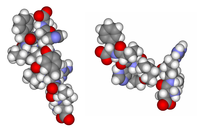
Vascular angiotensin AT1 receptor neuromodulation in fetal programming of hypertension.
Sign Up to like & getrecommendations! Published in 2019 at "Vascular pharmacology"
DOI: 10.1016/j.vph.2018.10.003
Abstract: Fetal stress increases the susceptibility to cardiovascular diseases in adult age, including hypertension, a process known as fetal programming of hypertension (FPH). This study intends to investigate the interplay between vascular sympathetic nervous system (SNS)… read more here.
Keywords: fetal programming; programming hypertension; at1; hypertension ... See more keywords

Cartilage oligomeric matrix protein is an endogenous β-arrestin-2-selective allosteric modulator of AT1 receptor counteracting vascular injury
Sign Up to like & getrecommendations! Published in 2021 at "Cell Research"
DOI: 10.1038/s41422-020-00464-8
Abstract: Compelling evidence has revealed that biased activation of G protein-coupled receptor (GPCR) signaling, including angiotensin II (AngII) receptor type 1 (AT1) signaling, plays pivotal roles in vascular homeostasis and injury, but whether a clinically relevant… read more here.
Keywords: matrix protein; cartilage oligomeric; at1 receptor; at1 ... See more keywords

Pulmonary alveolar type I cell population consists of two distinct subtypes that differ in cell fate
Sign Up to like & getrecommendations! Published in 2018 at "Proceedings of the National Academy of Sciences of the United States of America"
DOI: 10.1073/pnas.1719474115
Abstract: Significance Pulmonary alveolar type I (AT1) cells are essential for the gas-exchange function of lungs. AT1 cells retain their cellular plasticity during injury-induced alveolar regeneration. However, we know very little about the developmental heterogeneity of… read more here.
Keywords: at1 cell; at1 cells; at1; igfbp2 ... See more keywords

The inhibitory effect of BKCa channels induced by autoantibodies against angiotensin II type 1 receptor is independent of AT1R
Sign Up to like & getrecommendations! Published in 2018 at "Acta Biochimica et Biophysica Sinica"
DOI: 10.1093/abbs/gmy038
Abstract: Autoantibodies against angiotensin II Type 1 receptor (AT1-AA) are routinely detected in the serum of preeclampsia patients, which results in an increase in vascular tone and an elevation in intracellular calcium concentration of rat vascular… read more here.
Keywords: autoantibodies angiotensin; at1; bkca channels; receptor ... See more keywords

Effects and molecular mechanisms of AT1-AA in retinopathy of preeclampsia
Sign Up to like & getrecommendations! Published in 2019 at "Acta Biochimica et Biophysica Sinica"
DOI: 10.1093/abbs/gmy144
Abstract: Preeclampsia not only seriously endangers maternal and fetal health during pregnancy but may incur many sequelae in postpartum women such as reduced visual acuity. Agonistic autoantibodies to the angiotensin II type I receptor (AT1-AA) is… read more here.
Keywords: cell apoptosis; preeclampsia; at1; effects molecular ... See more keywords

Adjunctive therapy with statins reduces residual albuminuria/proteinuria and provides further renoprotection by downregulating the angiotensin II–AT1 pathway in hypertensive nephropathy
Sign Up to like & getrecommendations! Published in 2017 at "Journal of Hypertension"
DOI: 10.1097/hjh.0000000000001325
Abstract: Objectives: Blockade of the renin–angiotensin II (Ang II) system by AT1 blockers (ARBs) and angiotensin-converting enzyme inhibitors retards the progression of chronic kidney disease (CKD) by reducing albuminuria/proteinuria. However, many patients with CKD suffer from… read more here.
Keywords: residual albuminuria; adjunctive therapy; albuminuria proteinuria; at1 ... See more keywords

The non‐biphenyl‐tetrazole angiotensin AT1 receptor antagonist eprosartan is a unique and robust inverse agonist of the active state of the AT1 receptor
Sign Up to like & getrecommendations! Published in 2018 at "British Journal of Pharmacology"
DOI: 10.1111/bph.14213
Abstract: Conditions such as hypertension and renal allograft rejection are accompanied by chronic, agonist‐independent, signalling by angiotensin II AT1 receptors. The current treatment paradigm for these diseases entails the preferred use of inverse agonist AT1 receptor… read more here.
Keywords: at1 receptor; at1; inverse agonist; active state ... See more keywords

High salt induces cognitive impairment via the interaction of angiotensin II-AT1 and prostaglandin E2-EP1 systems.
Sign Up to like & getrecommendations! Published in 2023 at "British journal of pharmacology"
DOI: 10.1111/bph.16093
Abstract: BACKGROUND AND PURPOSE High salt (HS) intake has been associated with hypertension and cognitive impairment. It is well-known that angiotensin II (Ang II)-AT1 and prostaglandin E2 (PGE2)-EP1 systems are involved in hypertension and neurotoxicity. However,… read more here.
Keywords: at1 prostaglandin; high salt; at1; ep1 systems ... See more keywords

Neurovascular unit alteration in somatosensory cortex and enhancement of thermal nociception induced by amphetamine involves central AT1 receptor activation
Sign Up to like & getrecommendations! Published in 2017 at "European Journal of Neuroscience"
DOI: 10.1111/ejn.13594
Abstract: The use of psychostimulants, such as amphetamine (Amph), is associated with inflammatory processes, involving glia and vasculature alterations. Brain Angiotensin II (Ang II), through AT1‐receptors (AT1‐R), modulates neurotransmission and plays a crucial role in inflammatory… read more here.
Keywords: nociception; thermal nociception; at1; somatosensory cortex ... See more keywords

AT1-AA Exposure During Pregnancy Impairs Maternal Cerebral Blood Flow Autoregulation Postpartum
Sign Up to like & getrecommendations! Published in 2023 at "Physiology"
DOI: 10.1152/physiol.2023.38.s1.5729419
Abstract: Preeclampsia (PE), new-onset hypertension during pregnancy, is the leading cause of morbidity and mortality for the mother and the fetus. A leading cause of mortality during PE is cerebrovascular disease. Women with PE have activated… read more here.
Keywords: cerebral blood; autoregulation; at1; physiology ... See more keywords

MICU1-dependent mitochondrial calcium uptake regulates lung alveolar type 2 cell plasticity and lung regeneration
Sign Up to like & getrecommendations! Published in 2022 at "JCI Insight"
DOI: 10.1172/jci.insight.154447
Abstract: Lung alveolar type 2 (AT2) cells are progenitors for alveolar type 1 (AT1) cells. Although many factors regulate AT2 cell plasticity, the role of mitochondrial calcium (mCa2+) uptake in controlling AT2 cells remains unclear. We… read more here.
Keywords: at2 at1; alveolar type; cell; at1 ... See more keywords